Technical Assessment of Wind Energy Potentials in Bangladesh
DOI:
https://doi.org/10.37934/arfmts.96.2.1021Keywords:
Wind energy, wind conversion energy system, Weibull distribution, BangladeshAbstract
Wind power has experienced very rapid growth over the past two decades as major technological advances have been made to reduce the cost of producing electricity through wind. It is also renowned for its low maintenance and negligible effect on environmental pollution. The main purpose of this study is to evaluate and compare the wind energy potential in seven major districts of Bangladesh including Barisal, Chittagong, Dhaka, Khulna, Rajshahi, Rangpur, and Sylhet. Data had been recorded on daily basis for the consecutive five years from 2015 until 2019 and analyzed using the Weibull distribution function for various essential parameters such as wind speed, wind power density and Weibull parameters. Results show that the monthly average wind speed varies between 0.5 m/s to 2.10 m/s for all the divisions except Chittagong which is in the range between 3 m/s and 4.5 m/s. Similarly, the maximum wind power density and wind energy density were also found in the Chittagong division with annual densities that range between 51.86967 W/ to 84.01142 W/and 454.3783 KWh/ to 753.94 KWh/, respectively. The shape and scale parameters (k and c) are varying between 0.774373 – 1.086069 and 0.684588 – 1.735511 m/s, respectively for all the divisions except Chittagong where it ranges between 1.463098 – 1.625881 and 3.131256 – 4.28601 m/s, respectively. Meanwhile, the prevailing wind directions vary from one division to another but mainly between the south and east. This, this study strongly recommends the Chittagong division for the utilization of the potentiality of wind energy typically for small-scale applications.
Downloads
































